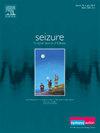Respiratory modulation of heart rate variability after generalized convulsive seizures
IF 2.8
3区 医学
Q2 CLINICAL NEUROLOGY
引用次数: 0
Abstract
Background
Autonomic function is modulated by the respiratory network. We therefore hypothesized that in persons with epilepsy (PWE), generalized convulsive seizures (GCS) would induce greater heart rate variability (HRV) and parasympathetic activation in patients with low interictal central CO2 chemosensitivity (measured with the hypercapnic ventilatory response, HCVR). We further hypothesized that postictal HRV would be associated with severity of postictal hypercapnia and hypoxemia.
Methods
We performed a retrospective analysis of PWE admitted to an epilepsy monitoring unit for video-EEG study and experienced GCS. Time synchronized video-EEG, ECG, respiratory effort, and airflow were continuously measured along with transcutaneous CO2 and O2 saturation. Interictal HCVR was measured using a modified hyperoxic rebreathing technique. Postictal respiration was analyzed and included the magnitude and duration of CO2 rise and O2 desaturation. HRV measures were derived from 5-minute artifact-free ECG recordings from interictal and postictal periods. Relationships between HRV and respiratory variables were analyzed using Spearman’s correlation and multivariate models.
Results
Twenty-six patients had both a GCS and an interictal HCVR. Mean age was 36.6 (±11.8) years and mean duration of epilepsy 16.2 (±12.0) years. Interictal HCVR slope varied from -0.13 to 5.2 (median 2.1) L/min/mm Hg and was not related to postictal RMSSD or the change in RMSSD (interictal wake – postictal) induced by GCS (p > 0.11). In contrast, duration of postictal hypercapnia and oxygen desaturation were both significantly correlated with overall postictal HRV (SDNN) and with multiple HRV measures of parasympathetic tone (RMSSD, HF power, Cardiac Vagal Index). In multivariate analyses, duration of postictal oxygen desaturation was positively associated with increased postictal RMSSD (mean ratio 1.09, 95 % CI 1.04–1.14, p < 0.01).
Conclusions
Postictal ventilation and oxygenation are tightly coupled to multiple measures of heart rate variability, consistent with respiratory modulation of the autonomic nervous system. Patients with more severe postictal respiratory depression exhibit greater parasympathetic activity after GCS even while the frequent occurrence of postictal tachycardia suggests a concomitant increase in sympathetic activity. These results have implications for the interpretation of postictal bradycardia and respiratory dysfunction and their relationships to sudden unexpected death in epilepsy.
全身性惊厥发作后心率变异性的呼吸调节
自主神经功能是由呼吸网络调节的。因此,我们假设在癫痫患者(PWE)中,全身性惊厥发作(GCS)会导致间歇期中枢性CO2化学敏感性低的患者(用高碳酸血症通气反应(HCVR)测量)更大的心率变异性(HRV)和副交感神经激活。我们进一步假设,阳性HRV可能与阳性高碳酸血症和低氧血症的严重程度有关。方法回顾性分析在癫痫监护病房接受视频脑电图检查和经历GCS的PWE患者。连续测量时间同步视频-脑电图、心电图、呼吸力、气流以及经皮CO2和O2饱和度。采用改良的高氧再呼吸技术测量间期HCVR。分析后呼吸,包括CO2升高和O2去饱和的幅度和持续时间。HRV测量来源于间隔期和间隔期的5分钟无伪影心电图记录。采用Spearman相关和多变量模型分析HRV与呼吸变量之间的关系。结果26例患者同时发生GCS和间期HCVR。平均年龄36.6(±11.8)岁,平均癫痫持续时间16.2(±12.0)年。间期HCVR斜率变化范围为-0.13 ~ 5.2(中位数为2.1)L/min/mm Hg,与术后RMSSD或GCS引起的RMSSD(间期尾流-术后)变化无关(p >;0.11)。相反,术后高血氧血症和氧去饱和持续时间均与术后总HRV (SDNN)和副交感神经张力的多项HRV测量(RMSSD、HF功率、心脏迷走神经指数)显著相关。在多变量分析中,术后氧去饱和持续时间与术后RMSSD增加呈正相关(平均比值1.09,95% CI 1.04-1.14, p <;0.01)。结论体位通气和氧合与心率变异性的多项指标密切相关,与自主神经系统的呼吸调节一致。更严重的后置呼吸抑制患者在GCS后表现出更大的副交感神经活动,即使频繁发生的后置心动过速表明交感神经活动随之增加。这些结果对解释后置性心动过缓和呼吸功能障碍及其与癫痫猝死的关系具有启示意义。
本文章由计算机程序翻译,如有差异,请以英文原文为准。
求助全文
约1分钟内获得全文
求助全文
来源期刊

Seizure-European Journal of Epilepsy
医学-临床神经学
CiteScore
5.60
自引率
6.70%
发文量
231
审稿时长
34 days
期刊介绍:
Seizure - European Journal of Epilepsy is an international journal owned by Epilepsy Action (the largest member led epilepsy organisation in the UK). It provides a forum for papers on all topics related to epilepsy and seizure disorders.
 求助内容:
求助内容: 应助结果提醒方式:
应助结果提醒方式:


